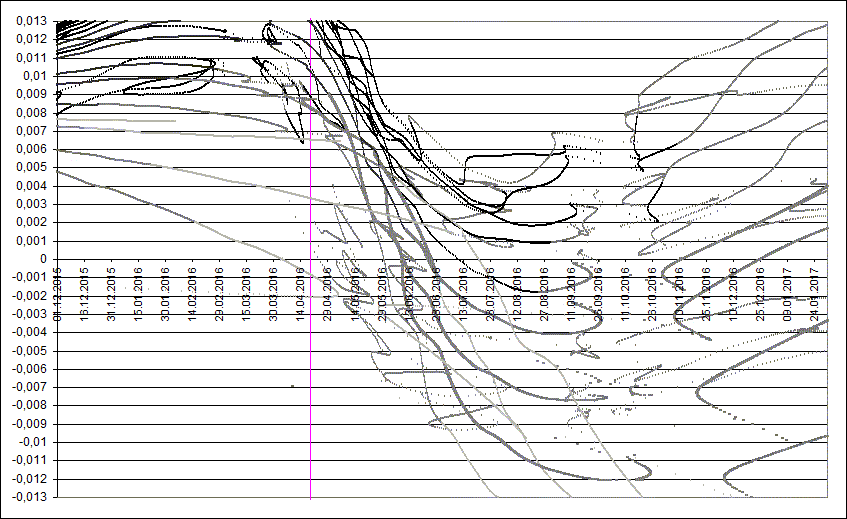P\2009 WX5 Catalina-ids 2016: prediction of activity
to the list of predictions

Fig. 1. Space-temporal projection of P\2009 WX5 Catalina-ids trails parts onto their minimal distance passages in 2016 (correspondence between colours of the particles and their ejection velocities can be seen here).
In 2015 the comet P\2009 WX5 Catalina passes its perihelion, and the distance between its and the Earth orbits will be 0.00768 AU. Computation results show the chances for radiometeor activity of the comet stream in 2016, at 2:02 UT on 21 April, when the Earth passes at 0.00092 AU from the young 1988 trail. The encountered trail part is composed of particles with very high ejection velocity 67.14 m/s, which is put toghether with very small size of comet nucleus and the radiant situated in the sky close to the Sun (elongation is only 24°). All this effectively cancels any chances of visual activity detection, but it is quite probable that some activity could be registered with radioobsevations. Theoretical radiant coordinates are: RA=37.7°, Dec=+35.1°, which is close to 14 Trianguli. Meteors entry velocity is 21.1 km/s, so perhaps this could be classified as a slow daylight radioshower. The high positive dectination of the shower radiant makes it a target primarily for observers in the Northern hemispere. If any activity occurs at the given time, then most favorable places for radioobservations would be with longutues between eastern part of Eurasia, starting from Western Siberia, and to North America continent, exluding its eastern part.
References
1. "Comet's dust 2.0" program by S. Shanov and S. Dubrovsky. [Used for orbital computations.]
2. Lyytinen E, van Flandern T. "Predicting the strength of Leonid outbursts", 2000, Icarus, P. 158-160.
3. Kasuo Kinoshita, http://jcometobs.web.fc2.com/ [Orbital elements of the comet P\2009 WX5 Catalina]
References
1. "Comet's dust 2.0" program by S. Shanov and S. Dubrovsky. [Used for orbital computations.]
2. Lyytinen E, van Flandern T. "Predicting the strength of Leonid outbursts", 2000, Icarus, P. 158-160.
3. Kasuo Kinoshita, http://jcometobs.web.fc2.com/ [Orbital elements of the comet P\2009 WX5 Catalina]